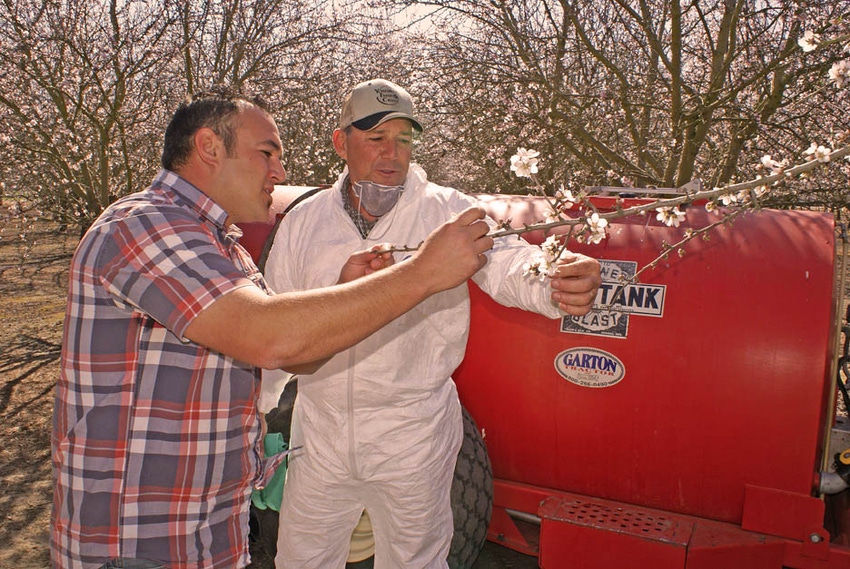April 15, 2013

Like many California almond growers, Eric Genzoli has been able to manage what, at one time, was the most difficult insect pest in almonds: navel orangeworm. With timely winter sanitation, he rarely, if ever, resorts to dormant, or even hullsplit, sprays to control NOW, and yet his reject levels are well below industry standards.
In fact, according to aggregate data gathered from growers through the California Almond Sustainability Program (CASP), more than 85% of California Almond growers practice winter sanitation to control navel orangeworm, shaking and poling stick-tight mummies during the winter, and mowing them to destroy overwintering worm pests.
The ability to compare his operation to other almond growers throughout the state through the sustainability program is just one advantage of CASP, according to Genzoli, who farms in Stanislaus County.
Genzoli has participated in CASP since 2011, completing modules for each of his orchards on pest, nutrient and irrigation management, energy efficiency and air quality.
Genzoli filled out the assessments initially with his father, Brian, at a handler meeting in 2011, which he says was a good exercise for them to go through together as responsibility for more of the orchard’s management is being transferred from Brian to the 27-year-old Eric.
“For anyone who is going through that generational change with a son or grandson taking over management, it’s helpful to fill it out together and walk through the different practices on each block,” Eric Genzoli said.
It also gave them an instant glimpse into where their practices fit in relation to other almond growers throughout the state.
“When you see you are in a low percentile of participants who do a certain sustainable practice, you say, ‘Wow, a lot of people are doing this, and obviously they are getting some return on it,’” explained Genzoli. “‘Maybe it’s something I need to try on my orchard to be more efficient.’”
Genzoli, a member of this year’s Almond Leadership Program and currently in Class 43 of the California Ag Leadership Program, is the fourth generation to farm almonds on the family’s 200-acre orchard in Turlock and Hughson. After college, when he told his father he was ready to come back to work on the farm, his father advised him to first “go do something else.” So he taught English in Spain for a year, an experience that broadened his perspective and gave him even more appreciation for the value of his family’s farm.
Cloning almond info
Genzoli’s great-grandfathers on both sides of his family immigrated to the area: one from Italy via Switzerland and the other from the Azores in Portugal. They both started with small dairies in the late 1800s and converted to permanent plantings, including almonds.
Sustainability is an integral part of Genzoli’s pest management and other production practices, which basically involve looking at the big picture and broader impacts of every decision he makes in the orchard, he said.
In addition to practicing timely winter sanitation, Genzoli determines pest management treatment and timing through regular scouting and monitoring reports from his PCA. He is careful to calibrate, operate and maintain spray rigs to minimize drift and get the most efficacious and efficient spray application possible, he said.
These practices are also in line with the majority of California almond growers. Thanks to increased participation last year, the Almond Board of California is now able to say, with 95 percent confidence, that results from the CASP assessments are representative of what almond growers in general are doing across the state.
In the area of pest management, for instance, growers on a majority of orchards rely on pest monitoring and record keeping for pest management decisions. Ninety-two percent of orchards are regularly monitored. And growers for a majority of orchards count and remove mummy nuts in the winter, and make necessary hullsplit sprays on the basis of egg-trap counts and degree days.
Most growers also practice timely calibration of spray equipment and adjust spray patterns based on average tree size and shape, and discontinue sprays during row turns and near sensitive sites.
Genzoli says it is clear most growers use sustainable pest management practices. The next step is to get the information gathered through CASP to provide real data to back up those sustainability claims.
He says new online modules, which allow him to “clone” relevant information from orchards and production practices, have significantly reduced the time required to participate in the program.
“It probably takes two to three hours to initially complete the assessment, but then once it’s done, it takes only a few minutes to update the module each year, and click and transfer information between orchards,” states Genzoli.
Genzoli also appreciates that the online modules allow him to fill out some of the assessment at his convenience, and come back later and pick up right where he left off.
“You can do it five minutes a day or 10 minutes a day,” he said. “I mean, how can you not spend five minutes a day for the good of the entire almond industry? That’s what it’s all about — a proactive program to gather statistics about what almond growers are actually doing so we have the numbers to back up what we are saying. And the more we do it, the more we get numbers that are meaningful.”
Fill out self-assessments at SustainableAlmondGrowing.org. For a username, contact Kendall Barton by email or phone at (209) 343-3245. If you prefer to attend a workshop to fill out assessments, the next one will be held April 11 in Ballico. RSVP for this workshop to Kendall Barton.
More from Western Farm Press
GMO pickle claim leaves you scratching your head
GMO food labels won’t list whole truth
Wine sales break record as demand explodes
20 minutes of hail pound strawberry farmer
Wine grape frost protection concerns grow with water scarcity
You May Also Like




